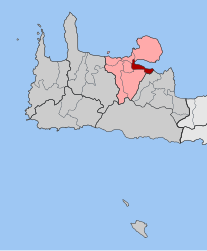Souda
Σούδα | |
|---|---|
 The cliff of Souda bay | |
| Coordinates: 35°29′N 24°04′E / 35.483°N 24.067°E | |
| Country | Greece |
| Administrative region | Crete |
| Regional unit | Chania |
| Municipality | Chania |
| Area | |
| • Municipal unit | 22.0 km2 (8.5 sq mi) |
| Population (2021)[1] | |
| • Municipal unit | 8,438 |
| • Municipal unit density | 380/km2 (990/sq mi) |
| • Community | 6,225 |
| Time zone | UTC+2 (EET) |
| • Summer (DST) | UTC+3 (EEST) |
| Vehicle registration | ΧΝ |
Souda (Greek: Σούδα) is a town and former municipality in the Chania regional unit, Crete, Greece. Since the 2011 local government reform it is part of the municipality Chania, of which it is a municipal unit.[2] The municipal unit has an area of 22.007 km2 (8.497 sq mi).[3] It is an important ferry and naval port at the head of Souda Bay.
Souda is 6.5 kilometres (4.0 miles) to the east of central Chania, although the area in between is mostly built-up. The town is a relatively new settlement, built on what used to be salt beds and marshland. The Turks knew the area as 'Tuzla', their name for salt-beds.[citation needed] In the 1870s, they began to build a new settlement here which grew as the port expanded. Souda Bay is one of the deepest natural harbours in the Mediterranean and is easy to defend.[citation needed]
Now Souda is the arrival point for ferries from Piraeus. There is also a naval base located in Souda and across the bay, for NATO, with military accommodation and hospital in the town. Much of the command, particularly for US forces, is found across the bay on the Akrotiri. A grain silo overshadows the centre of town. Perhaps because of its nature as a working port and military town, it is not popular with tourists and can appear seedy[citation needed], however, the central square was upgraded in 2020.[citation needed] It is well-served with shops of all types and some renowned fish restaurants in the old centre.
The Allied War Cemetery, mostly of soldiers from World War II, is found in Souda on the shore. There are 1,527 graves, mostly British with 447 New Zealanders and 197 Australians. Buried in the cemetery is the archaeologist John Pendlebury. Pendlebury was the curator at Knossos for the British School in Athens and had been continuing excavations in Crete until the war. He was executed by the Germans in 1941 whilst working for British Intelligence.[citation needed]
- ^ "Αποτελέσματα Απογραφής Πληθυσμού - Κατοικιών 2021, Μόνιμος Πληθυσμός κατά οικισμό" [Results of the 2021 Population - Housing Census, Permanent population by settlement] (in Greek). Hellenic Statistical Authority. 29 March 2024.
- ^ "ΦΕΚ B 1292/2010, Kallikratis reform municipalities" (in Greek). Government Gazette.
- ^ "Population & housing census 2001 (incl. area and average elevation)" (PDF) (in Greek). National Statistical Service of Greece.

